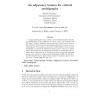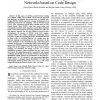115
click to vote
SIAMDM
2010
14 years 11 months ago
2010
Abstract. We investigate the degree distribution resulting from graph generation models based on rank-based attachment. In rank-based attachment, all vertices are ranked according ...
100
Voted
INFOCOM
2010
IEEE
14 years 11 months ago
2010
IEEE
—In this paper, we develop an analytical framework which explains the emergence of superpeer networks on execution of the commercial peer-to-peer bootstrapping protocols by incom...
132
Voted
CCR
2002
15 years 20 days ago
2002
It has long been thought that the Internet, and its constituent networks, are hierarchical in nature. Consequently, the network topology generators most widely used by the Interne...
102
click to vote
CORR
2006
Springer
15 years 26 days ago
2006
Springer
Abstract. It is widely believed that the Internet's AS-graph degree distribution obeys a power-law form. However, it was recently argued that since Internet data is collected ...
100
click to vote
DM
2008
15 years 27 days ago
2008
In edge colouring it is often useful to have information about the degree distribution of the neighbours of a given vertex. For example, the well known Vizing's Adjacency Lem...
118
Voted
WSC
2008
15 years 3 months ago
2008
Recent research has shown that while many complex networks follow a power-law distribution for their node degrees, it is not sufficient to model these networks based only on their...
INFOCOM
2003
IEEE
15 years 6 months ago
2003
IEEE
— Considerable attention has been focused on the properties of graphs derived from Internet measurements. Router-level topologies collected via traceroute-like methods have led s...
104
click to vote
WAW
2007
Springer
15 years 7 months ago
2007
Springer
Traceroute sampling is an important technique in exploring the internet router graph and the autonomous system graph. Although it is one of the primary techniques used in calculati...
112
click to vote
SECON
2007
IEEE
15 years 7 months ago
2007
IEEE
—In this paper, we develop a joint Network Coding (NC)-channel coding error-resilient sensor-network approach that performs In-Network Processing based on channel code Design (IN...


